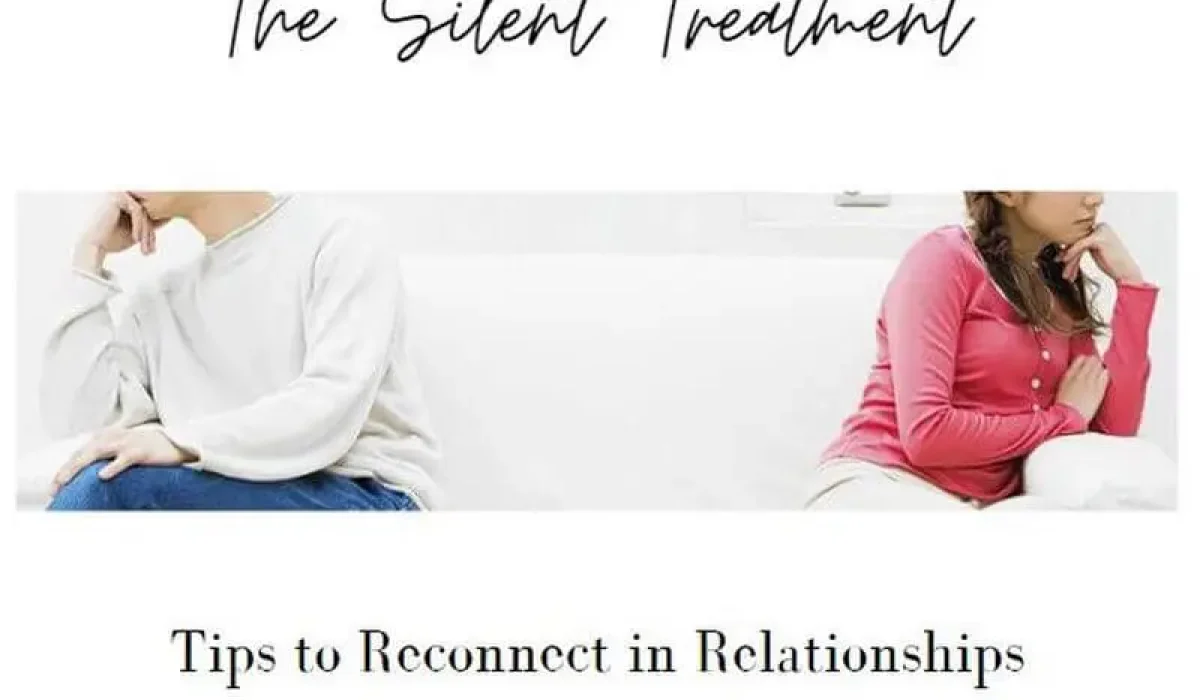The Silent Treatment is a common problem in many relationships. It can be a frustrating and hurtful experience for both parties involved. The silent treatment is often used as a way to express anger or disapproval without having to confront the other person. However, this behavior can quickly turn into a vicious cycle, leading to resentment, isolation, and even relationship breakdown. If you are in this situation, it’s essential to understand why silent treatment is harmful and how to break the cycle.
In this post, we will explore the root causes of the silent treatment, how to recognize it, and most importantly, how to break the cycle and reconnect in your relationships. Whether you’re experiencing the silent treatment or are guilty of using it yourself, keep reading to learn how to overcome this toxic behavior and build stronger connections with those you care about.
Table of Contents
1- What is the silent treatment?
The Silent Treatment is a form of emotional abuse that involves ignoring or refusing to communicate with someone. It can occur in any relationship, including romantic, familial, or even professional. The person giving the silent treatment may do so to punish the other person, gain control or power over them, or avoid conflict or confrontation. The person on the receiving end of the silent treatment may feel confused, hurt, and rejected. They may try to reach out and communicate with the person giving the silent treatment but often receive no response. Over time, this can lead to a breakdown in communication and trust, and can even result in the end of the relationship. It’s essential to recognize the signs of the silent treatment and to take steps to break the cycle and reconnect with the person giving it.
2- Why is the silent treatment used in relationships?
The silent treatment is often used as a form of emotional punishment or manipulation in relationships. It can be used as a way to gain control over the other person or to express anger, frustration, or disappointment without having to communicate directly. Some people may also use the silent treatment as a way to avoid conflict or as a defense mechanism to protect themselves from being hurt.
However, the silent treatment can be incredibly damaging to any relationship. It can create feelings of resentment, loneliness, and frustration, and can erode the trust and intimacy that is essential for a healthy relationship to thrive. It can also lead to a breakdown in communication and can make it difficult to resolve conflicts or misunderstandings.
It’s important to recognize that silent treatment is not an effective way to communicate emotions or resolve issues in a relationship. Instead, it’s important to practice open and honest communication, even if it feels uncomfortable or difficult. This can involve actively listening to your partner’s concerns and expressing your own calmly and respectfully. By breaking the cycle of silent treatment and working together to improve communication, you can strengthen your relationship and deepen your connection.
3- The effects of the silent treatment on relationships
The silent treatment can be detrimental to any relationship, whether it be romantic, familial, or professional. When one person decides to stop communicating with the other, it creates a void that can cause feelings of loneliness, frustration, and anger. The person being ignored may become anxious and try to do anything to get the attention of the other, while the one giving the silent treatment may feel powerful and in control.
The effects of the silent treatment can be long-lasting and damaging. It can create resentment, erode trust, and damage the emotional bond between two people. When communication breaks down, misunderstandings can arise and lead to further conflict. It can also cause a lack of closure, leaving both parties feeling unresolved and unable to move on.
In romantic relationships, the silent treatment can be particularly damaging. It can lead to feelings of rejection, insecurity, and abandonment in the other person. It can also create a toxic dynamic where one person always has power and control, while the other is left feeling vulnerable and helpless.
To break the cycle of silent treatment, it’s important to understand the negative effects it can have on a relationship. Both parties need to be willing to communicate openly and honestly with each other and to work together to find a solution. Learning to express emotions in a healthy way, and practicing active listening skills can also help to prevent the silent treatment from occurring in the first place. By working together, couples, family members, and coworkers can create stronger, healthier relationships built on mutual respect and understanding.
4- How to recognize when you are giving or receiving the silent treatment
The silent treatment is a passive-aggressive behavior that can be incredibly hurtful to the person on the receiving end. It’s important to recognize when you are giving or receiving silent treatment in order to break the cycle and reconnect in your relationships.
If you find yourself ignoring someone or avoiding communication, you may be giving silent treatment. This behavior can be a way to punish someone without having to confront the issue directly. It’s important to recognize that this behavior is not a healthy way to communicate and can cause serious damage to your relationships.
On the other hand, if you are on the receiving end of the silent treatment, you may feel confused, hurt, and frustrated. You may be left wondering what you did wrong and how you can fix things. It’s important to recognize that you are not responsible for someone else’s behavior and that you deserve to be treated with respect and kindness.
Recognizing when the silent treatment is happening in your relationships is the first step to breaking the cycle and reconnecting with the person you care about. By addressing the issue directly, expressing your feelings, and actively listening to the other person, you can begin to rebuild trust and strengthen your relationship. Keep in mind that effective communication is essential for any relationship to succeed.
5- How to break the cycle of the silent treatment
Breaking the cycle of silent treatment can be challenging, but it is crucial for the health of any relationship. The first step is to acknowledge the problem and communicate with your partner about it. Explain how the silent treatment makes you feel and how it affects the relationship. It’s essential to do this in a calm and respectful manner, without placing blame or becoming defensive.
Next, it’s important to identify the underlying cause of the silent treatment. Is it a result of a disagreement or conflict that was not fully resolved, or is it a deeper issue related to past traumas or insecurities? Once the root cause is identified, both partners can work together to find solutions and make changes to prevent it from happening in the future.
Another effective way to break the cycle of silent treatment is to practice active listening. This means giving your partner your full attention and trying to understand their perspective without interrupting or becoming defensive. By doing so, you can show your partner that you value and respect their opinions, and this can help to rebuild trust and strengthen the connection between you both.
Finally, it’s important to be patient and persistent. Breaking the cycle of silent treatment won’t happen overnight, and it may require continued effort and commitment from both partners. But with open communication, active listening, and a willingness to work together, it is possible to break the cycle and reconnect in a meaningful way.
6- Strategies for opening up communication in relationships
When communication breaks down in a relationship, it can be difficult to know how to start repairing it. However, there are strategies that can help you open up communication channels and reconnect with your partner.
One of the most effective strategies is to start small. Instead of trying to address all of the issues at once, focus on one specific topic that you feel comfortable discussing. This could be something as simple as planning a weekend getaway or deciding on a restaurant to try.
Another strategy is to use “I” statements instead of “you” statements. For example, instead of saying “You never listen to me,” try saying “I feel like I’m not being heard.” This approach is less likely to put your partner on the defensive and can help facilitate a more productive conversation.
It’s also important to practice active listening. This means giving your partner your full attention when they are speaking and making an effort to really understand their perspective, without interrupting or getting defensive.
Finally, consider seeking the help of a professional. A couples therapist can help you and your partner work through communication issues and develop strategies for improving your relationship. Remember, communication is key in any relationship, and taking steps to improve it can lead to a stronger and healthier partnership.
7- Tips for active listening and effective communication
Effective communication depends heavily on active listening. It involves being fully present at the moment and paying close attention to what the other person is saying. When someone is speaking, avoid interrupting or planning what you are going to say next. Instead, focus on what the person is saying, and try to understand their perspective.
When you actively listen, you are showing the other person that you value their thoughts and feelings. Building trust and strengthening your relationship can result from doing so. Additionally, active listening can help to prevent misunderstandings and conflicts.
Effective communication also involves expressing yourself clearly and respectfully. Avoid using accusatory language or making assumptions about the other person’s intentions. Instead, use “I” statements to express how you feel and what you need from the other person. As an example, “When you don’t listen to me, I feel hurt. Can we work on communicating better?”
Remember, communication is a two-way street. It’s important to listen to the other person’s perspective, but it’s also important to express your own thoughts and feelings. By using active listening and effective communication techniques, you can break the cycle of silent treatment and reconnect with those you care about.
8- How to rebuild trust and connection after the silent treatment
Rebuilding trust and connection after the silent treatment can be challenging, but it is possible. The first step is to acknowledge and address the behavior that led to the silent treatment. It’s important to have an open and honest conversation about what happened and why it happened. This can be difficult, but it’s necessary to move forward.
Once you have had an open conversation, it’s important to actively listen to your partner and understand their perspective. It’s important to show empathy and try to see things from their point of view. This can help rebuild trust and connection by showing that you care about their feelings and are willing to work through the issue together.
It’s also important to make a commitment to change and follow through on that commitment. This means being consistent in your behavior and actions and following through on any promises you make. This can help rebuild trust and connection by showing that you are committed to the relationship and willing to put in the effort to make things work.
Lastly, it’s important to practice forgiveness. Forgiveness is not about forgetting what happened, but it’s about letting go of the anger and resentment that can build up after the silent treatment. This can be challenging, but it’s necessary to move forward and rebuild trust and connection in the relationship.
9- The importance of seeking outside help when needed
Sometimes, despite all our efforts, it can be difficult to break the cycle of the silent treatment and reconnect in our relationships. In such cases, seeking outside help can be crucial in finding a way forward.
There are many professionals who specialize in relationship counseling and therapy. They can provide a safe and non-judgmental space for couples to work through their issues and find a way to reconnect.
It’s important to note that seeking outside help does not mean that you or your partner have failed in any way. In fact, it shows great strength and willingness to work on the relationship and find a way forward. A trained professional can help you identify the root causes of the silent treatment and provide practical strategies to overcome it.
Additionally, outside help can also come in the form of trusted friends or family members who may offer a fresh perspective and provide support during this difficult time.
Remember, silent treatment can be a damaging cycle for any relationship, but it doesn’t have to be the end of the road. Seeking outside help can be a powerful step towards breaking the cycle and rebuilding a strong and healthy connection with your partner.
10- Conclusion and final thoughts on the silent treatment in relationships
In conclusion, silent treatment can be incredibly damaging to any relationship. It is a toxic behavior that can lead to a breakdown in communication, a loss of trust, and ultimately, the end of a relationship. While it may feel like a form of protection or a way to cope with difficult emotions, it is not a healthy or effective method of communication.
If you find yourself giving or receiving silent treatment, it is important to address it as soon as possible. Communication is key in any relationship, and it is important to have an open and honest dialogue about how you are feeling.
It may be helpful to seek the assistance of a therapist or counselor to work through any underlying issues that may be contributing to the silent treatment. Remember, it takes effort and commitment from both parties to repair a relationship that has been damaged by the silent treatment.
Breaking the cycle of the silent treatment and reconnecting in relationships will require ongoing effort and dedication, but it is possible. By acknowledging the issue, working on communication skills, and prioritizing the relationship, you can overcome this destructive behavior and build a stronger, healthier relationship.




